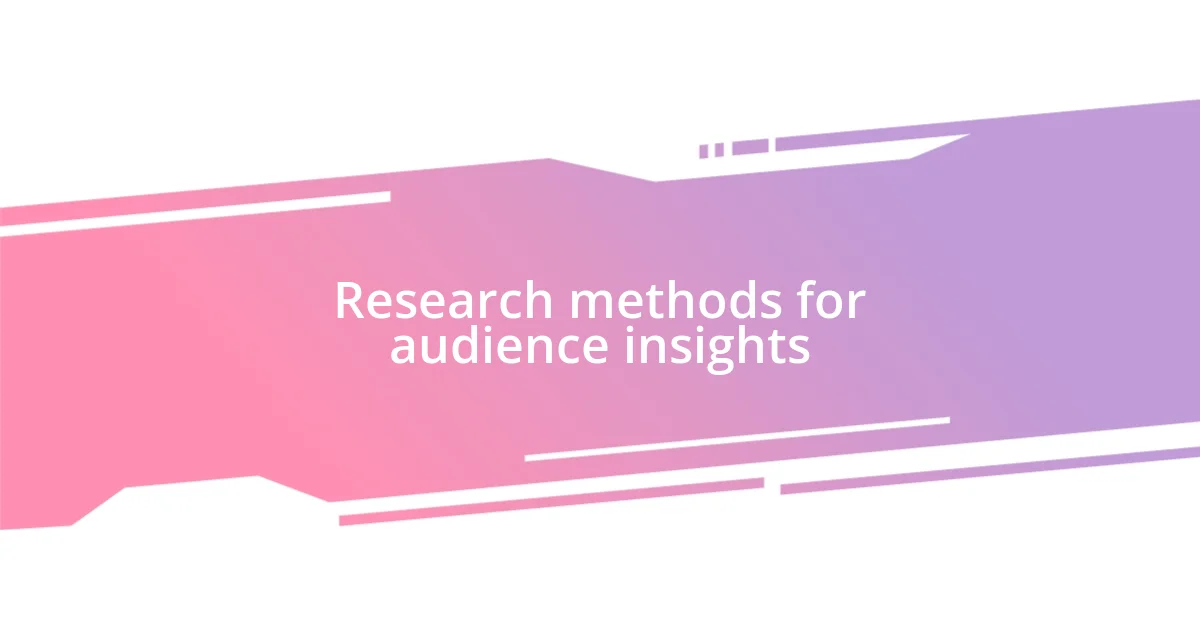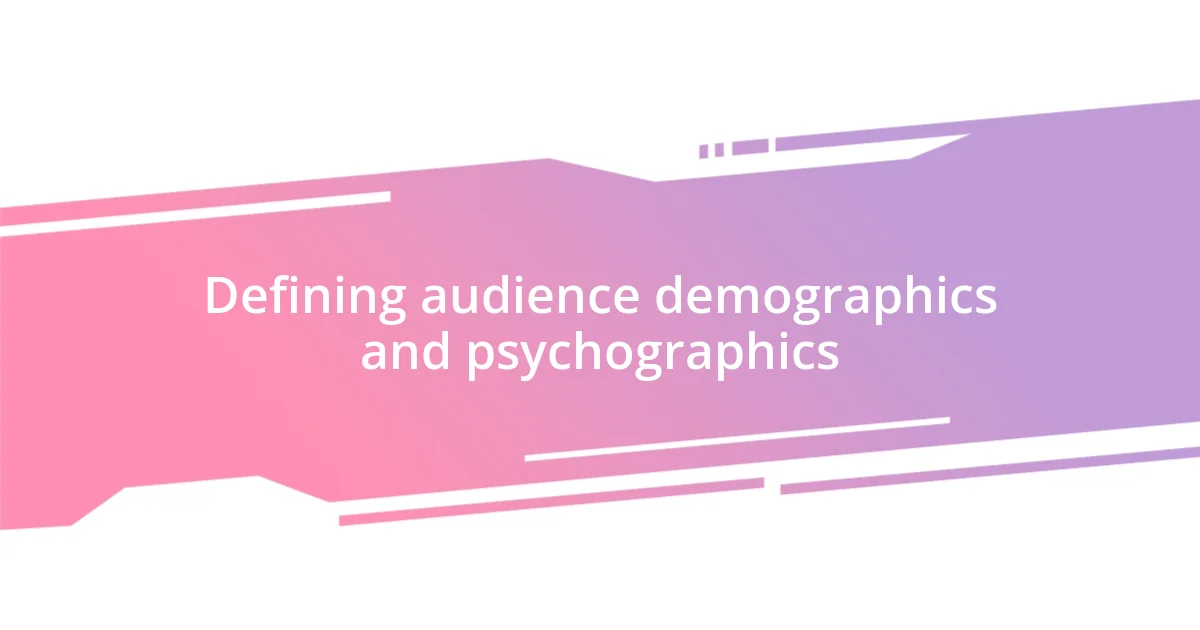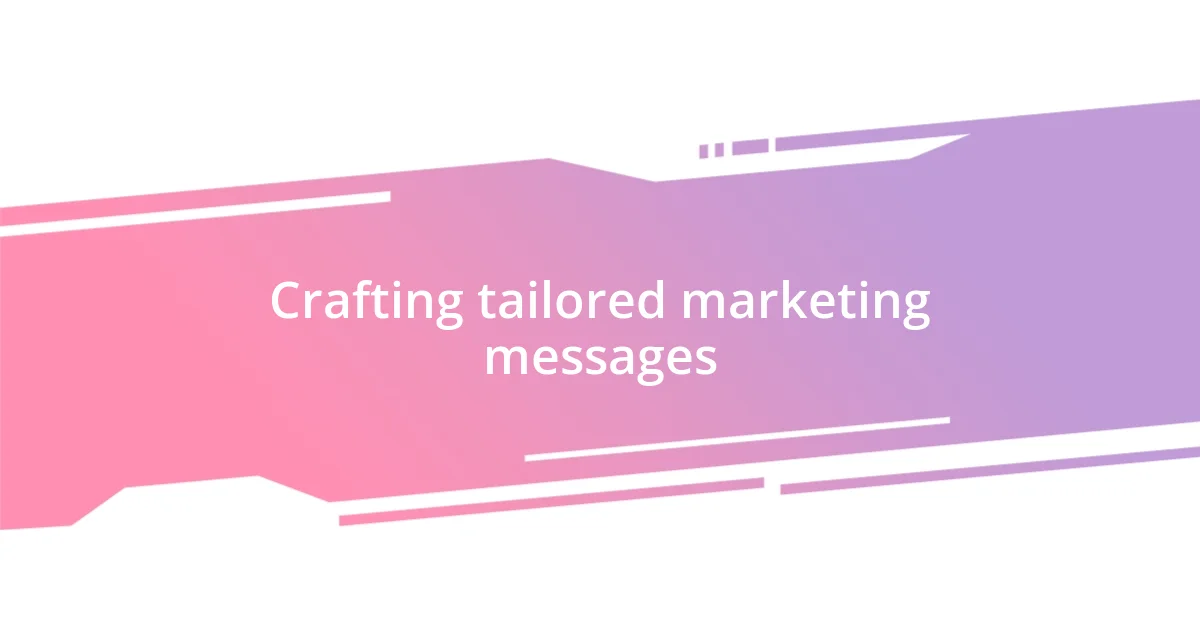Key takeaways:
- Understanding your target audience is essential for creating personalized and effective marketing messages that resonate emotionally with specific segments.
- Audience segmentation enhances engagement by allowing tailored strategies, resulting in improved resource allocation and deeper connections.
- Incorporating feedback into marketing strategies fosters loyalty and adaptability, leading to more relevant and impactful campaigns.

Understanding your target audience
Understanding your target audience is crucial for any successful campaign. I remember the first time I tried to market a small online shop. I assumed everyone would love my products, but I quickly learned that you can’t serve everyone. Knowing who your ideal customers are helps you create messages that resonate with them on a personal level. Have you ever felt like a brand was speaking directly to you? That’s the magic of truly understanding your audience.
Effective audience insights come from both research and intuition. When I launched a new service, I conducted surveys to uncover my audience’s needs and preferences. The responses were eye-opening, revealing gaps I hadn’t considered. That’s when I started crafting my content to directly address their pain points. It’s amazing what you can learn when you take the time to really listen to those you hope to connect with.
It’s also important to recognize the diversity within your audience. I vividly recall a project where we targeted millennials, only to find that our messaging was flat for a large segment of Gen Z. This taught me to appreciate the nuances in age groups, interests, and values. By embracing this diversity, I learned to tailor my message and make it more inclusive. How can you adapt your approach to better connect with different segments in your audience?

Importance of audience segmentation
Audience segmentation is essential because it allows marketers to tailor their messages and strategies to specific groups, resulting in increased engagement. I recall guiding a friend in her marketing efforts for a wellness workshop. Initially, she employed a one-size-fits-all approach and saw minimal interest. Once she segmented her audience based on interests like yoga, nutrition, and mental health, the response vastly improved. This experience drove home the idea that focusing on the nuances within your audience can lead to more meaningful connections.
When I reflect on my own campaigns, the importance of audience segmentation becomes even clearer. For instance, while promoting a local charity event, targeting families with kids and young professionals separately helped us craft vastly different appeals. Families resonated with activities for children, while young professionals were drawn by the networking opportunities. This distinct messaging created excitement around the event in a way that generalized appeals never could. Ultimately, segmentation offers a pathway to authentic engagement, matching the right message with the right audience.
Segmentation also feeds into the effectiveness of marketing budgets. I learned this while managing my social media ads. Initially, I had a broad target, but switching to segmented audiences allowed for better allocation of my ad spend. By investing in targeted ads based on specific demographics and interests, I saw a significant increase in conversions. It was a game changer! How do you see segmentation impacting your own marketing efforts?
| Benefits of Audience Segmentation | Impact on Marketing |
|---|---|
| Personalization | Increased engagement and loyalty |
| Efficiency | Better allocation of resources and budget |
| Insights | Deeper understanding of audience preferences |

Research methods for audience insights
Researching your audience can feel like embarking on a treasure hunt. Each method reveals priceless insights that can help shape your marketing strategies. One of my favorite techniques is leveraging analytics tools. For example, when I analyzed website traffic, I discovered visitors weren’t just coming from my social media posts but were also intrigued by blog content I hadn’t prioritized. This revelation made me realize the importance of producing targeted articles that resonate with specific audience segments.
Here are some effective research methods that I’ve found beneficial:
- Surveys and Questionnaires: Direct feedback is invaluable. I often send out short surveys, and the responses can highlight trends and preferences that I hadn’t considered.
- Social Media Listening: Monitoring conversations on social platforms lets me grasp what potential customers truly care about. I once noticed a recurring question in comments that spurred me to create a helpful FAQ resource.
- Focus Groups: I’ve hosted small group discussions where participants share thoughts on concepts or products. It’s fascinating to hear their insights firsthand.
- Website Analytics: Using tools like Google Analytics can show me where visitors spend the most time and what drives conversions, guiding content creation efforts.
- Competitor Analysis: Observing how others engage their audiences helps me refine my approach. I once noted a competitor’s successful campaign that inspired a new strategy of my own.
By exploring these methods, I’ve cultivated a deeper connection with my audience. The process is dynamic, often revealing new dimensions of their needs and desires that I may not have anticipated. It’s truly rewarding to adapt and grow from these insights, allowing for more authentic engagement.

Defining audience demographics and psychographics
When it comes to audience demographics, I’ve found that understanding the basic attributes—age, gender, income level, and education—forms the foundation of effective targeting. For instance, I once worked on a campaign for a luxury skincare brand aimed at women aged 30-50. By focusing on this demographic, I realized their interests in sustainability and high-quality ingredients bridged their lifestyle choices with the brand’s mission.
But demographics tell only part of the story; psychographics delve deeper into the audience’s values, interests, and motivations. I remember brainstorming with my team about why young adults were hesitant about a subscription service. Through discussions, we uncovered that their reluctance stemmed from a desire for authenticity and transparency in brands. This revelation shifted our approach, allowing us to incorporate more genuine storytelling into our messaging, which resonated profoundly with them.
Isn’t it fascinating how understanding the emotions behind consumer behavior can elevate your marketing strategy? One time, I crafted a campaign that highlighted personal stories from real users rather than just focusing on the product features. This emphasis on experiences completely changed how our audience engaged with our message. By embracing both demographics and psychographics, your marketing can create a more relatable and authentic connection with your audience, don’t you think?

Crafting tailored marketing messages
Crafting marketing messages that resonate with your audience requires a fine balance between creativity and insight. I’ve learned that personal anecdotes can really make a difference. For instance, when I tailored a message for a health-focused product, I shared my own journey of adopting a healthier lifestyle. This not only made the message relatable but sparked conversations with customers who felt a connection to my story—showing them that I genuinely understood their struggles.
Moreover, I find that integrating emotions into marketing messages can be incredibly powerful. During a recent campaign for a non-profit, we emphasized stories of community impact rather than just listing services. By showcasing how our work directly affected individuals, we created a message that was not only informative but also moved people to action. Hasn’t anyone else felt compelled to respond when they see real stories of change? I certainly have, and I try to incorporate that emotional appeal into my own strategies.
Tailoring messages to meet the unique passions and concerns of your audience can lead to surprising results. I remember launching a product aimed at eco-conscious consumers, highlighting sustainability efforts in every communication. The result? A surge in engagement, as customers felt their values were aligned with our mission. This experience underscored how crucial it is to listen and adapt your messaging—authenticity truly wins hearts and minds.

Measuring audience engagement effectively
Measuring audience engagement effectively isn’t just about tracking likes or shares; it’s about understanding the quality of those interactions. One campaign I worked on involved a social media challenge, and beyond the numbers, I noticed that conversations around the challenge created a vibrant community. This informal feedback loop allowed me to gauge not just interest, but a deep emotional investment from the participants—something that analytics tools can sometimes miss. How often do we consider the quality of engagement over the quantity?
I also rely heavily on metrics like comment sentiment and user-generated content to paint a fuller picture of engagement. For example, during a tech product launch, I encouraged users to share their experiences with our product via videos. The excitement in their testimonials was palpable, and analyzing those sentiments provided valuable insights into what really resonated with them. I often wonder how many brands overlook these gems, focusing instead solely on surface-level metrics.
Another effective approach I’ve found is utilizing tools like heat maps on websites to see where users are most engaged. On a recent project, we implemented this on a landing page, and it revealed that users were overwhelmingly interacting with specific sections. This insight prompted us to enhance those areas further, which ultimately increased conversion rates. Isn’t it fascinating how these small adjustments based on engagement data can lead to significant improvements?

Adjusting strategies based on feedback
Adjusting strategies based on feedback is crucial for maintaining relevance and effectiveness. I remember a project where we launched a new service. Initially, the response was lukewarm, but then we started receiving feedback about what was missing. Listening to those voices allowed me to tweak our messaging and add features the audience craved. This adjustment not only rekindled interest but also established a deeper trust with our clients. Isn’t it incredible how open ears can turn a lukewarm response into something special?
Feedback also plays a vital role in shaping the content I create. In one campaign, I asked my audience directly what topics mattered to them. The responses were enlightening. By incorporating their suggestions into future content, I made them feel heard and valued. This adaptation fostered loyalty and drove higher engagement. Have you ever wondered how impactful it can be to let your audience steer the conversation? It’s a game changer.
Finally, I can’t emphasize enough the importance of being flexible in your approach. After a recent webinar, several participants expressed a desire for more interactive elements. Instead of ignoring this feedback, I revamped the next session to include polls and breakout discussions. The change resulted in a noticeable increase in attendance and excitement. Reflecting on this, I often think: How much more could we achieve if we stayed just a step ahead by responding to feedback? It’s a constant journey of evolution.












